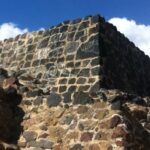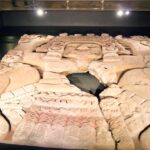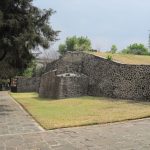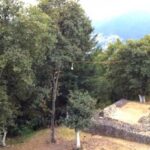_
The National Palace takes up the entirety of the east side of the Zócalo. It’s the seat of the Executive Branch of the Mexican Federal Government. It takes up some 40,000 square meters and has been a World Heritage Site since 1987.
Construction began on the complex in 1522. It was to be the second private residence of Hernán Cortés, built on top of part of the existing palace of the Huey Tlatoani, Moctezuma Xocoyotzin. With the fall of ancient Tenochtitlán, the Spanish Crown declared it the seat of the Viceroys of New Spain. It operated as such for about 300 years.
A great fire destroyed much of the complex in 1692. The palace was rebuilt over much of the next decades. With Mexican independence achieved in 1821, it became the seat of the executive, legislative and judicial powers. This remained the case despite the 19th century’s multiple regime changes between republican and monarchical regimes. It was also the personal residence of all the rulers between 1822 and 1884, with the exception of Maximiliano who resided in Chapultepec Castle from 1864-67. Thereafter, the presidential office was in the National Palace until 1968. It partially served again as the presidents´ office beginning in 2012, and fully in 2018.
It has permanently served as the setting for official, protocol, and civic acts of the Presidency of the Republic throughout all of these years. Heads of State and foreign governments are received here, credential letters from the diplomatic corps are delivered here. The official Cry of Dolores festivities are held here each September 15th, and Mexican Independence is celebrated here on the following day.
Over the past 500 years of its history, the building has been modified and extended many times. The National Palace bears Neoclassical, Baroque and Neo-colonial elements. The present appearance is the result of major work during the second decade of the 20th century when a third level was added.
With a valuable historical-artistic heritage, the Diego Rivera murals are magnificent examples of art that can be found inside.
 +52 (55) 3688 1255
+52 (55) 3688 1255
 http://www.palacionacionaldemexico.mx/
http://www.palacionacionaldemexico.mx/

0.12 kms.

One of the oldest and most significant archaeological zones in Mexico City.

One of the most important sites in the city, even today, don't miss the chance to visit the Templo Mayor.

The Plaza de las Tres Culturas is one of the most touching and informative places to stand in the modern city, past, present, and future.

One of the city's newest archaeological sites, it's one of the oldest and deepest of shrines in the Valley.

One of the oldest archaeological sites in the Valley, Mazatepetl is of Otomi origin, and fascinating to gnaw on.